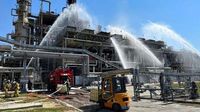On October 28, 2025, Ukrainian President Volodymyr Zelenskyy announced a significant escalation in Ukraine’s campaign against Russia’s oil industry, declaring that Ukrainian long-range strikes have already reduced Russia’s oil refining capacity by 20%. Drawing from Western intelligence, Zelenskyy emphasized that over 90% of these deep strikes on Russian territory were carried out with Ukrainian-made long-range weapons—a testament, he said, to the country’s growing domestic defense industry.
The timing of Ukraine’s intensified campaign coincides with a new wave of sanctions from the United States and the European Union, all aimed at cutting into Moscow’s oil and gas export earnings—the financial lifeblood supporting Russia’s ongoing invasion of Ukraine. Oil exports have long played a central role in funding the Kremlin’s war machine, and as Zelenskyy put it, “Russian oil refining is already paying a tangible price for the war – and will pay even more.”
According to the Associated Press, these strikes have not only impacted Russia’s refining capacity but have also caused fuel shortages in 57 regions, forcing the country to import fuel from China and Belarus. Fuel prices in Russia have surged, with Rosstat, the Russian state statistics agency, recording a 2.58% increase in September 2025—the sharpest monthly rise since 2018—and a staggering 12.73% annual growth rate, the highest in 14 years.
Behind Ukraine’s strategy lies the mass production of a new domestically engineered “Flamingo” cruise missile, which boasts a range of 3,000 kilometers and a half-ton warhead. National Security Journal reports that the Flamingo, measuring six meters in length and powered by a jet engine, is guided by GPS and internal navigation, achieving a circular error probable of just 15 meters. While not as precise as some Western munitions, Ukrainian defense officials argue that this level of accuracy is more than sufficient when targeting sprawling refinery complexes.
Ukraine’s recent strikes are part of a broader plan to “expand the geography” of its long-range operations, Zelenskyy stated, vowing that Russia’s oil industry would “pay even more” for the war. “We set tasks to expand the geography for the use of our long-range capabilities,” he wrote on social media following a high-level staff meeting on Ukraine’s military planning and defense production. The meeting, according to National Security Journal, reviewed the results of recent long-range strikes and coordinated future operations, including the ramp-up of domestic missile production.
American support has played a pivotal role in Ukraine’s campaign. The Trump administration, as reported by TNND and National Security Journal, has not only imposed sanctions on Russian oil giants Rosneft and Lukoil—set to take effect on November 21, 2025—but has also stepped up intelligence-sharing with Kyiv. U.S. President Donald Trump’s administration has provided Ukraine with targeting data that, according to anonymous intelligence officials quoted by National Security Journal, exceeds the assistance previously offered under the Biden administration. Treasury Secretary Scott Bessent, in a written statement, called for “an immediate ceasefire,” noting, “Treasury is sanctioning Russia’s two largest oil companies that fund the Kremlin’s war machine. Treasury is prepared to take further action if necessary to support President Trump’s effort to end yet another war. We encourage our allies to join us and adhere to these sanctions.”
The sanctions package is sweeping in scope. Not only do they bar U.S. businesses from dealing with Rosneft and Lukoil, but they also carry the threat of secondary sanctions on foreign banks that handle transactions with these companies. As AP and TNND explain, this means any bank wishing to maintain access to the U.S. financial system will think twice before doing business with the sanctioned oil giants. Lukoil, for its part, has announced plans to sell off its international assets in response to the sanctions, with a grace period allowing transactions until November 21. The company has stakes in oil and gas projects across 11 countries, including refineries in Bulgaria, Romania, and the Netherlands.
China and India, as the two largest buyers of Russian oil, have come under increasing scrutiny. Zelenskyy noted that India “has definitely given all the signals that it will reduce imports of energy resources” from Russia, while expressing hope that Trump’s upcoming meeting with Chinese President Xi Jinping in South Korea on October 30 will yield further reductions in Chinese purchases of Russian crude. The strategic aim is clear: by squeezing Russia’s energy revenues from all angles—military strikes, sanctions, and diplomatic pressure—Ukraine and its allies hope to force Moscow to the negotiating table.
Despite these efforts, the war shows no sign of ending as it approaches its fourth year. The Kremlin has demonstrated little willingness to compromise, and Russian forces have launched renewed offensives in Ukraine’s east. Over the past six months, Ukraine has captured 2,200 Russian prisoners of war in the eastern region, where Russia’s larger army is pushing to capture the city of Pokrovsk. To bolster its own defenses, Kyiv is shoring up troop numbers and holding parallel talks with Sweden, France, and the U.S. to build up its future combat aviation potential—Zelenskyy has requested a fleet of 250 new aircraft in total.
Ukraine’s own energy security is also under threat, with Russian attacks targeting Ukrainian energy infrastructure as winter approaches. Zelenskyy revealed that Ukraine has secured 70% of the $2 billion needed to fund gas imports for the coming heating season. By next month, Ukraine expects to be producing between 500 and 800 interceptors per day to counter Russia’s Shahed drone attacks, though he acknowledged that operators will need training to use them effectively. “We must secure specific air defense supplies from our partners – they have the necessary systems,” Zelenskyy said, emphasizing the urgent need for international support.
Looking ahead, Ukraine’s strategy is to lock in all deep-strike goals and expand its long-range strike footprint by the end of 2025. As Zelenskyy wrote, “All deep-strike goals must be fully locked in by year’s end, including expansion of our long-range footprint.” The combination of deep strikes on Russian oil facilities and international sanctions is designed to create a synergistic economic impact, further straining Moscow’s ability to sustain its war effort.
For now, Ukraine’s campaign is having a measurable effect. With Russia’s refining capacity degraded, fuel shortages mounting, and international pressure increasing, the war’s economic front is heating up. Whether these measures will be enough to force a breakthrough at the negotiating table remains to be seen, but the stakes for both sides—and for the global energy market—could hardly be higher.


